12 Best Competitor Analysis Tools for 2025
Staying ahead in today's market isn't about guesswork; it's about data-driven strategy. A deep understanding of your competitors' moves, from their ad spend and content to their landing page designs, provides the critical insights needed to innovate and capture market share. However, manually tracking every rival is a monumental, if not impossible, task. This is where dedicated software becomes essential.
The right platform can automate data collection, reveal hidden opportunities, and turn complex market signals into a clear action plan. The challenge lies in selecting from a crowded market of tools, each offering a different set of features and catering to specific needs. Whether you're a SaaS startup analyzing a rival's funnel, a product manager tracking feature releases, or an entrepreneur identifying market gaps, the perfect tool for your objective exists. Beyond just identifying competitors, these tools provide crucial data for developing effective comprehensive SEO strategies that drive organic growth.
This guide cuts through the noise to detail the 12 best competitor analysis tools, each with unique strengths. We’ll move past generic feature lists to provide a practical breakdown of what each platform does best, complete with screenshots, direct links, and ideal user profiles. We'll explore specific use cases, from SaaS landing page optimization with tools like Pages.Report to enterprise-level social listening with Brandwatch, helping you select the perfect software to transform competitive data into a strategic advantage.
1. Pages.Report
Best For: SaaS startups, marketers, and designers seeking actionable landing page inspiration.
Pages.Report offers a unique and highly practical approach to competitor analysis, focusing exclusively on deconstructing high-converting SaaS landing pages. Instead of providing broad SEO or traffic metrics, it dives deep into the design, copy, and UI patterns that are proven to work, making it an indispensable resource for teams looking to optimize their most critical marketing asset. The platform indexes hundreds of successful SaaS landing pages, turning them into a searchable library of actionable insights.
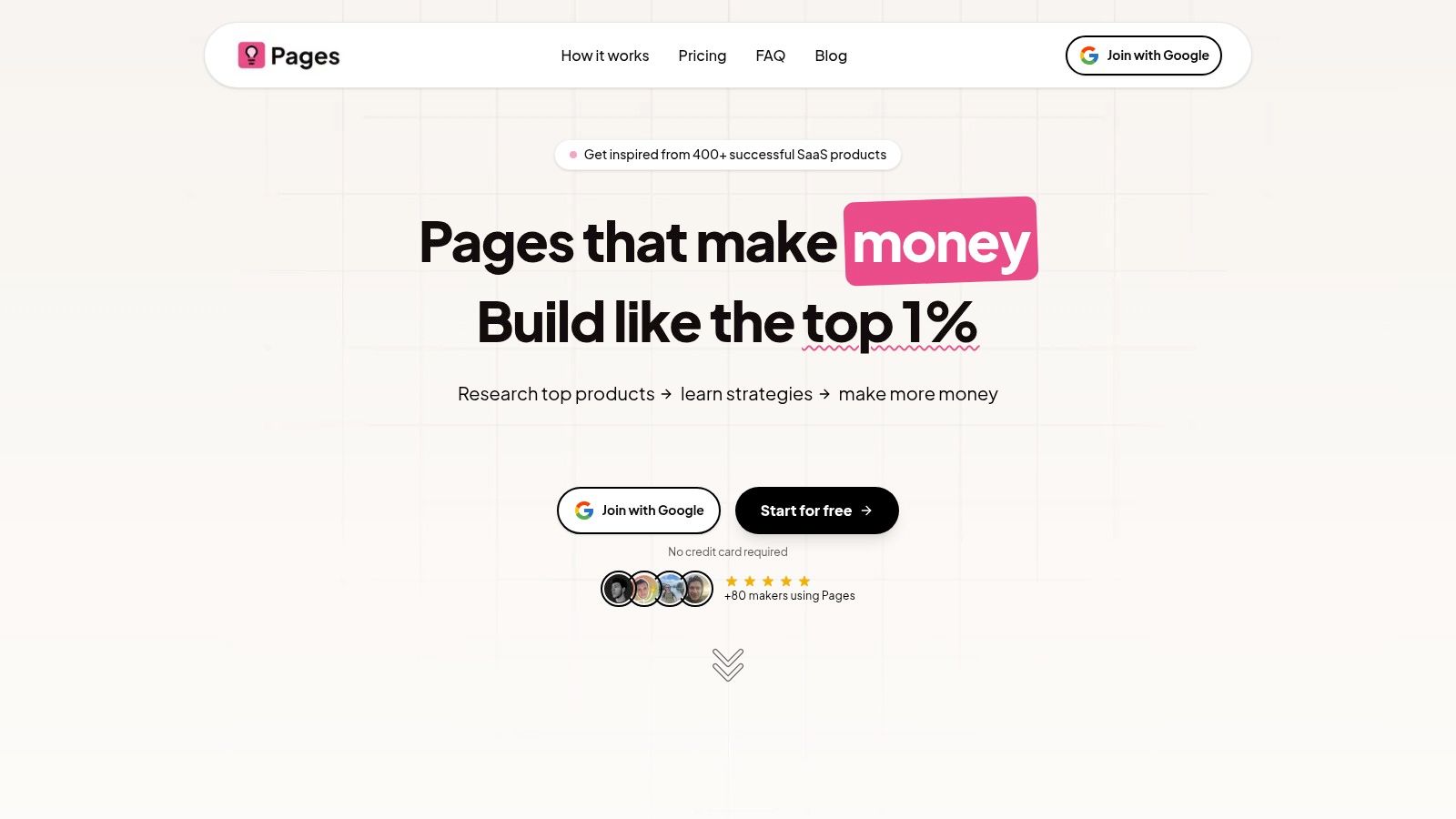
What sets Pages.Report apart is its focus on output-oriented deliverables. Users don't just get inspiration; they get tangible assets. This includes Figma-ready designs, optimized headline formulas, and implementation code for frameworks like Webflow and Framer. This transforms competitive research from a passive activity into an active part of the design and development workflow, significantly reducing the time it takes to test and deploy proven conversion strategies. For SaaS teams that need to move fast and avoid reinventing the wheel, this tool is one of the best competitor analysis tools available for landing page optimization.
Key Features & Analysis
- Actionable Deliverables: The platform provides Figma files and code-ready assets, allowing teams to directly implement observed patterns from competitors. This bridges the gap between research and execution.
- Data-Backed Library: With a continuously updated database of ~400+ real-world SaaS landing pages across over 110 niche categories, users can analyze what top performers in their specific vertical are doing successfully. Social proof, including revenue figures and Product Hunt rankings, adds a layer of validation.
- Personalized Audit: The Pro package includes a free landing page audit, offering tailored, concrete recommendations to improve a user's existing page based on the platform's extensive data.
Pricing & Access
Pages.Report is highly accessible for startups and small teams. It offers a free starter tier (no credit card required) for users to explore the core offering. For full access, it currently features a limited-time "All in One" lifetime deal priced at $29, making it a very cost-effective investment for its specialized function.
| Plan | Price | Key Benefit |
|---|---|---|
| Starter | Free | Access to a limited set of reports. |
| All in One | $29 (Lifetime Promotion) | Full access to all reports & future updates. |
Pros and Cons
Pros:
- Highly Practical: Focuses on actionable outputs (Figma, code) that directly accelerate design and development.
- Niche SaaS Focus: The curated library is tailored specifically for SaaS companies, ensuring relevant and high-quality examples.
- Extremely Cost-Effective: The free tier and affordable lifetime deal provide immense value for budget-conscious teams.
- Continuous Updates: The promise of weekly reports ensures the library remains current with the latest trends.
Cons:
- Narrow Scope: It is a specialized research tool, not a full-suite A/B testing or CRO platform.
- Implementation Required: The insights and assets still need to be implemented and validated by the user's team.
- Promotional Uncertainty: The highly attractive pricing is presented as a limited-time offer, and some features are still in development.
Website: https://pages.report
2. Semrush
Semrush is an all-in-one marketing intelligence platform that offers a formidable suite of features for comprehensive competitor analysis. While widely known for its core SEO and PPC capabilities, it provides deep insights into your rivals' digital strategies, making it one of the best competitor analysis tools for teams needing an integrated solution. You can uncover competitors' top organic keywords, analyze their backlink profiles, dissect their paid ad campaigns, and even estimate their website traffic and audience demographics.
What sets Semrush apart is its breadth. The Market Explorer and Traffic Analytics tools move beyond simple keyword tracking to provide a market-level view, helping you benchmark your share-of-voice against key players. This allows you to identify traffic sources your competitors are leveraging that you might be missing. For a deeper dive into the fundamentals of search marketing, you can learn more about search engine optimization and how these insights apply.
Core Features & Use Case
- Organic & Paid Research: Identify the exact keywords competitors rank for and the ad copy they use to drive traffic.
- Market & Traffic Analytics: Benchmark your website traffic, audience engagement, and traffic sources against up to five competitors simultaneously.
- Kompyte Add-on: For enterprise needs, this module provides automated competitor change tracking and sales battlecards.
Pricing & Limitations
Pricing starts with the Pro plan at $129.95/month, scaling up to the Business plan at $499.95/month. Critical competitor analysis features like historical data and the Kompyte module are reserved for higher tiers or require custom contracts, significantly increasing the cost. The platform's vastness can also present a steep learning curve for new users trying to leverage its full potential effectively.
- Website: https://www.semrush.com
3. Ahrefs
Ahrefs is a powerhouse SEO toolkit renowned for its best-in-class backlink index and deep keyword intelligence. For those whose competitive research hinges on understanding link-building strategies and content performance, Ahrefs is one of the best competitor analysis tools available. Its Site Explorer module provides an incredibly detailed view of any competitor's organic traffic, backlink profile, paid keywords, and top-performing pages, all presented through a remarkably fast and intuitive user interface.
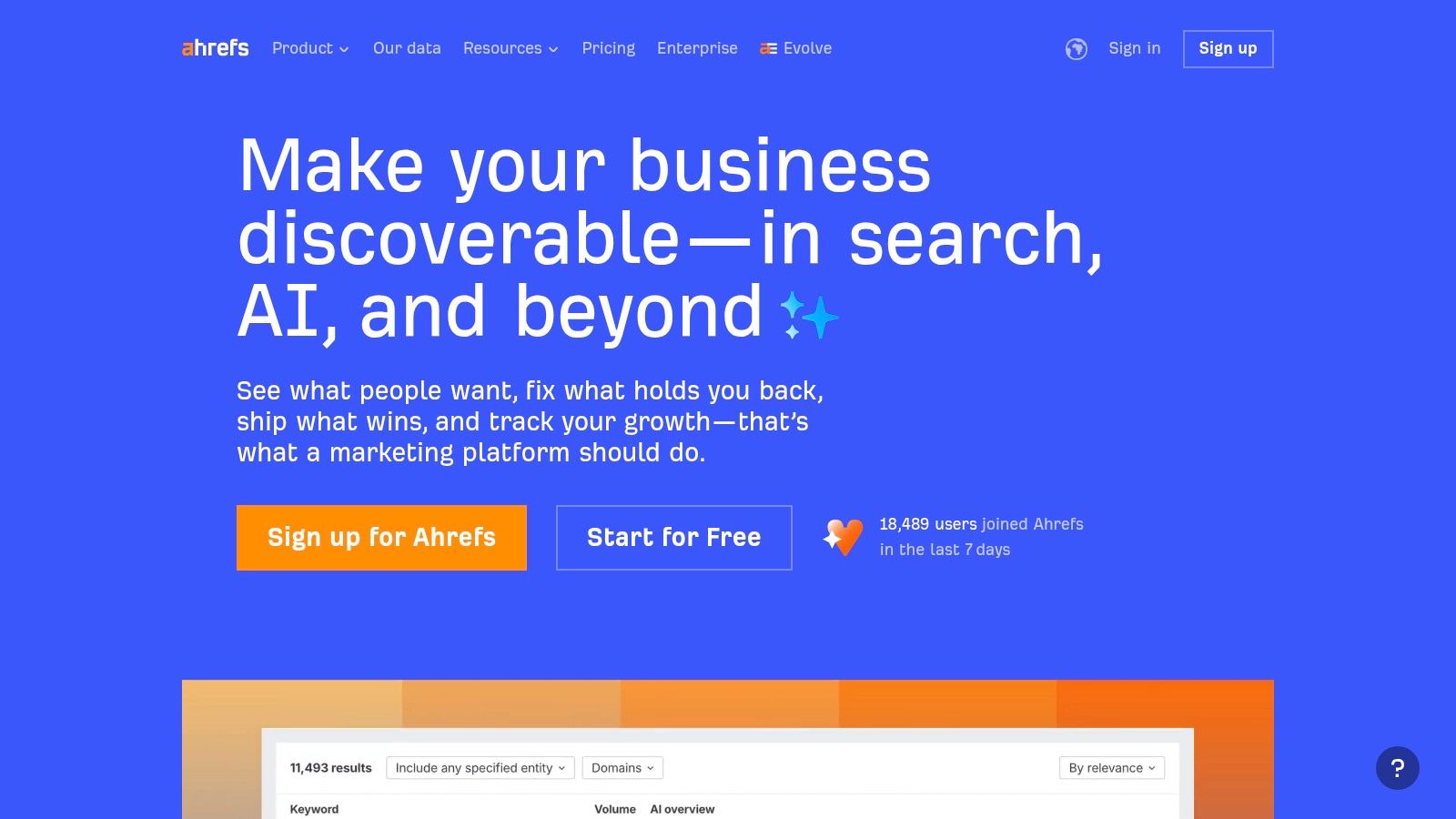
What truly distinguishes Ahrefs is the quality and depth of its backlink data. You can see not just who links to your competitors, but also identify new and lost links in near real-time. This granular insight is invaluable for reverse-engineering successful content marketing and digital PR campaigns. Furthermore, its Content Explorer helps you uncover content gaps by finding topics your rivals rank for that you haven't yet covered, providing a clear roadmap for your content strategy.
Core Features & Use Case
- Site Explorer: Dissect competitor websites to uncover their top organic keywords, strongest backlinks, and highest-traffic content pages.
- Content & Keyword Explorer: Perform in-depth content gap analysis and identify high-potential keywords your competitors are targeting.
- Competitive Analysis Module: Directly compare your domain's backlink profile, keyword rankings, and traffic metrics against multiple rivals.
Pricing & Limitations
Pricing begins with the Lite plan at $99/month, moving up to the Enterprise plan for large-scale needs. Ahrefs operates on a credit-based system, which means heavy usage of certain reports on lower-tier plans can quickly exhaust your monthly limits, potentially requiring an upgrade. While the core tools are comprehensive, some advanced features or higher data limits may necessitate purchasing add-ons or moving to more expensive plans.
- Website: https://ahrefs.com
4. Similarweb
Similarweb is a digital intelligence platform that excels at providing a high-level, market-wide view of competitor traffic and engagement. While other tools focus on granular SEO or PPC data, Similarweb’s strength lies in its ability to benchmark your digital footprint against the entire competitive landscape. It offers robust insights into where your competitors' traffic comes from, how their audience behaves, and which channels are most effective, making it one of the best competitor analysis tools for market-level strategic planning and enterprise reporting.
What truly sets Similarweb apart is its focus on traffic intelligence at scale. It moves beyond individual keyword rankings to provide aggregated data on traffic sources, referral sites, audience geography, and engagement metrics. This makes it an invaluable resource for understanding market share and identifying broader industry trends. For startups looking to size up a market, this kind of data is essential; you can find more platforms in our guide to market research tools for startups that complement this approach.
Core Features & Use Case
- Web Intelligence: Benchmark website traffic, engagement metrics, and audience demographics against an unlimited number of competitors with extensive historical data.
- Traffic & Engagement Analysis: Break down competitor traffic by source (Direct, Search, Social, etc.) to understand their marketing mix and identify new channel opportunities.
- Keyword & Ad Analysis: Uncover the top organic and paid keywords driving traffic to rivals and analyze their display advertising strategies.
Pricing & Limitations
Similarweb’s pricing is primarily geared towards enterprise clients, with custom quotes for its advanced packages. It offers a limited free version for basic website lookups. The paid plans, starting with Starter at $125/month and scaling to Professional at $333/month (billed annually), unlock more features. However, critical capabilities like deeper historical data, specific country filtering, and SERP analysis are reserved for higher-tier and enterprise plans, making the full suite of tools a significant investment.
- Website: https://www.similarweb.com
5. SpyFu
SpyFu is a highly focused SEO and PPC intelligence platform that excels at delivering actionable competitor data without a prohibitive price tag. It's designed for businesses that need to understand their rivals' Google strategies, from their most profitable keywords to their entire ad history. For teams prioritizing affordability and straightforward search marketing insights, SpyFu is one of the best competitor analysis tools available, offering a clear window into any domain's advertising and organic search performance.
What makes SpyFu particularly effective for small to medium-sized businesses is its emphasis on historical data and direct comparisons. You can track a competitor's ranking history, view every ad they've ever run on Google, and identify the keywords they share or those you are missing. Its "Kombat" feature allows for a direct domain-vs-domain comparison, visually highlighting keyword overlaps and opportunities in a way that is easy to understand and act upon.
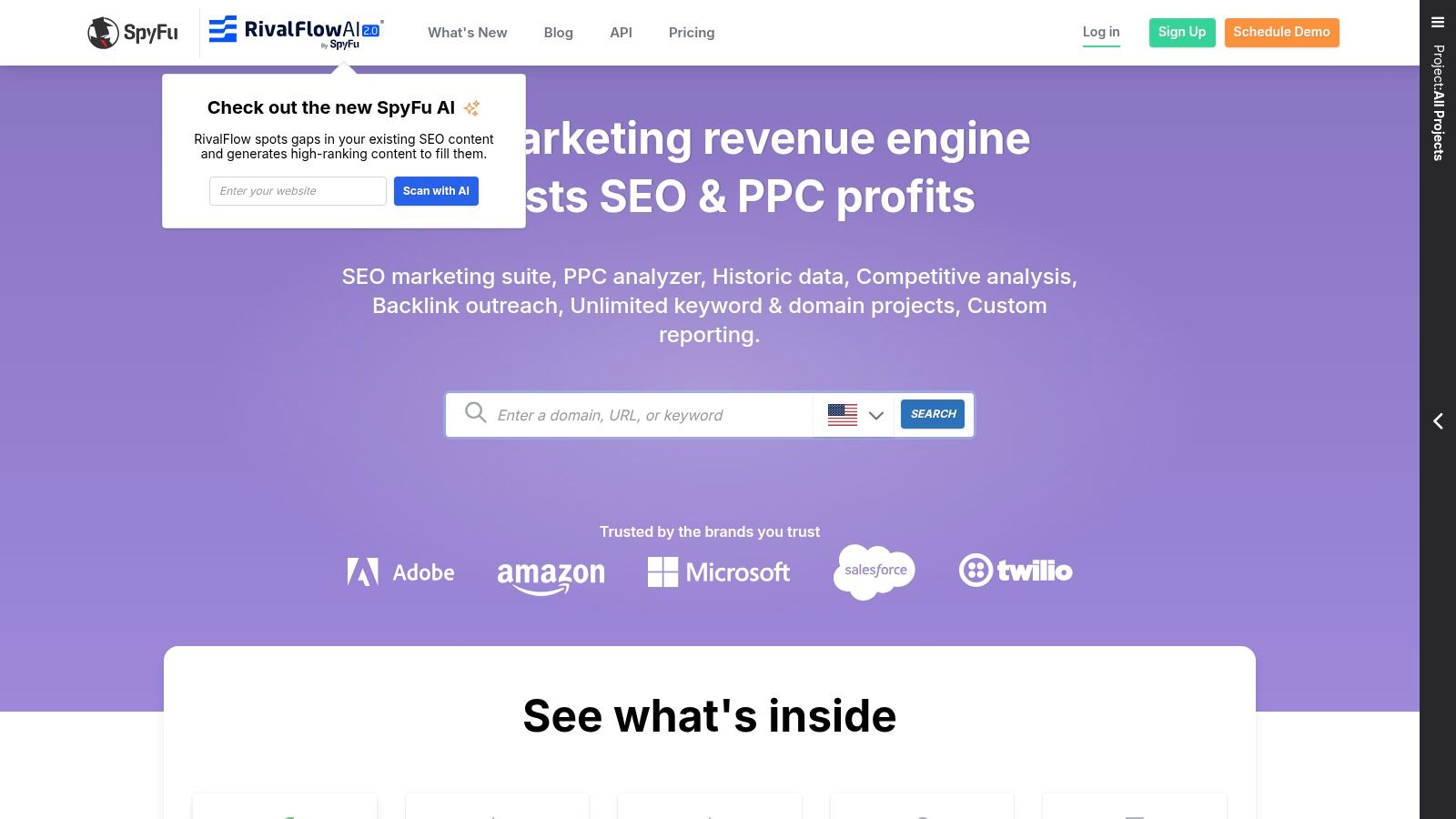
Core Features & Use Case
- PPC & SEO Competitor Research: Uncover the exact keywords competitors buy on Google Ads and the ones they rank for organically, including years of ad copy history.
- Kombat Domain Comparison: Directly compare your domain against two competitors to find common keywords and identify unique ranking opportunities.
- Lead Generation & Outreach: A unique feature that helps you find potential leads by filtering domains based on their ad spend, technology stack, or location.
Pricing & Limitations
SpyFu's pricing is one of its main advantages, starting with a Basic plan at $39/month and scaling to a Team plan at $299/month. Unlike many competitors, even the entry-level plan provides generous data limits. However, the user interface feels less polished than premium alternatives, and the depth of historical data can vary between different tools within the platform. The platform is also heavily focused on Google, offering less insight into other search engines or social media channels.
- Website: https://www.spyfu.com
6. Adbeat
Adbeat is a specialized advertising intelligence platform designed for teams that need to deconstruct their competitors' display and native ad strategies. It moves beyond keyword-based analysis to focus purely on visual advertising, offering a deep look into the creatives, ad placements, and estimated media spend of your rivals across a vast network of publishers. This makes it one of the best competitor analysis tools for performance marketers and media buyers who need to uncover what’s working in the visual ad space.
The platform's strength lies in its comprehensive creative database, allowing you to see the exact ad copy, imagery, and landing pages competitors are using to capture attention. You can filter by advertiser, publisher, or ad network to pinpoint specific campaigns and understand their reach and estimated budget. This insight is crucial for informing your own creative direction and optimizing media buying, helping you to better measure your marketing ROI on display and native channels.
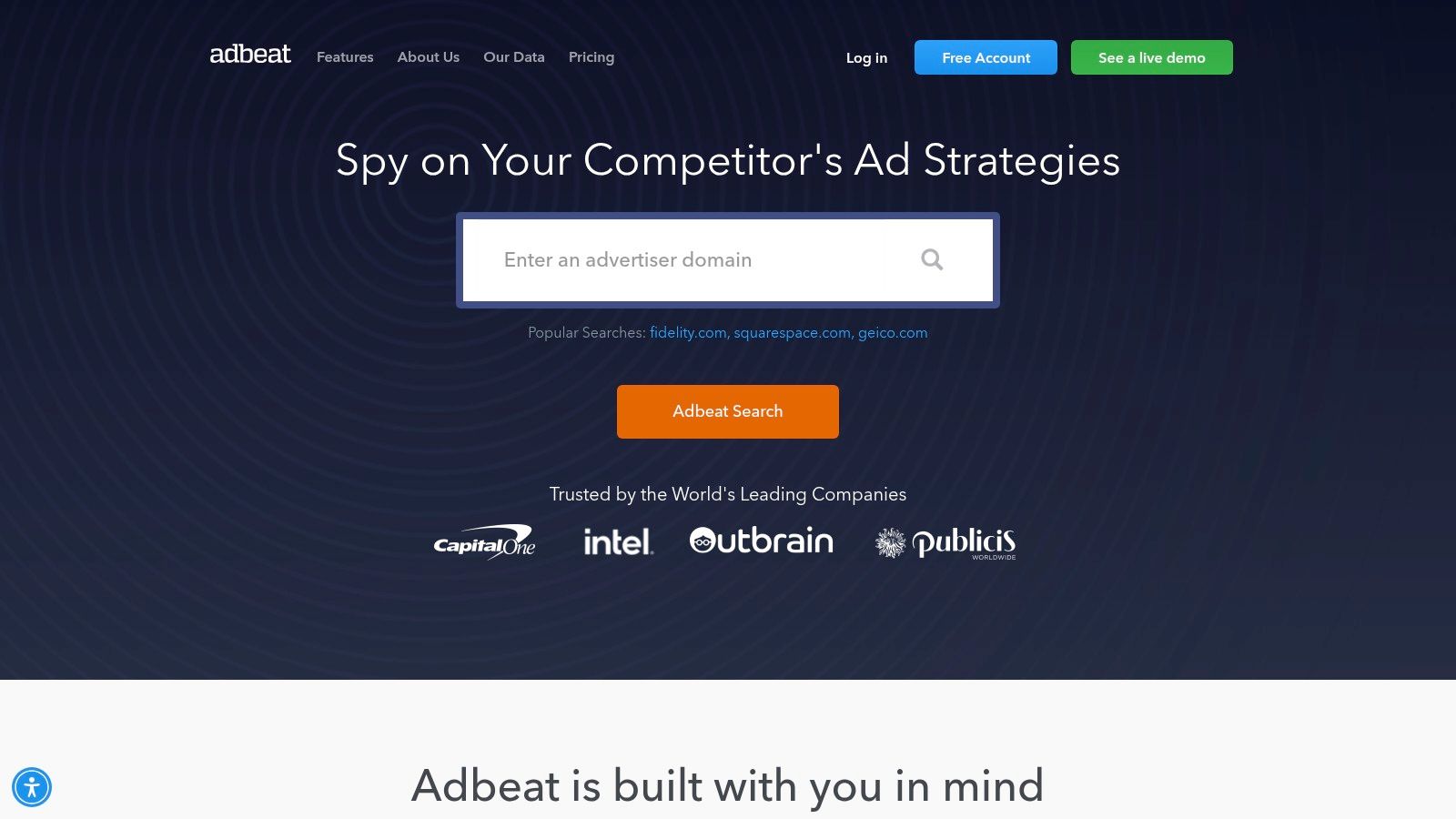
Core Features & Use Case
- Creative & Placement Discovery: Uncover competitors’ display, native, and direct-buy ad creatives and see which publishers they are running on.
- Publisher & Advertiser Intelligence: Compare advertisers to find new traffic sources or analyze publisher ad mixes to identify new partnership opportunities.
- Alerts & Reports: Set up automated alerts to track new creatives or campaigns from key competitors and download detailed reports for analysis.
Pricing & Limitations
Adbeat’s pricing is available upon request and is tailored to specific needs, starting with a Standard plan and scaling to Advanced and Enterprise tiers. There is no free trial listed for its primary plans, requiring a demo to get access. While the creative intelligence is extensive, users should note that the spend estimates are directional and not exact figures. Access to the API and certain premium networks is reserved for higher-tier plans.
- Website: https://www.adbeat.com
7. BuzzSumo
BuzzSumo is a specialized content marketing and PR intelligence platform that excels at revealing which content resonates most with audiences across any niche. While other tools focus on technical SEO, BuzzSumo zeroes in on the performance of articles, videos, and social media posts, making it one of the best competitor analysis tools for editorial, PR, and content strategy teams. It allows you to analyze competitor domains to see their most shared and linked-to content, track brand mentions, and identify key journalists and influencers covering your industry.
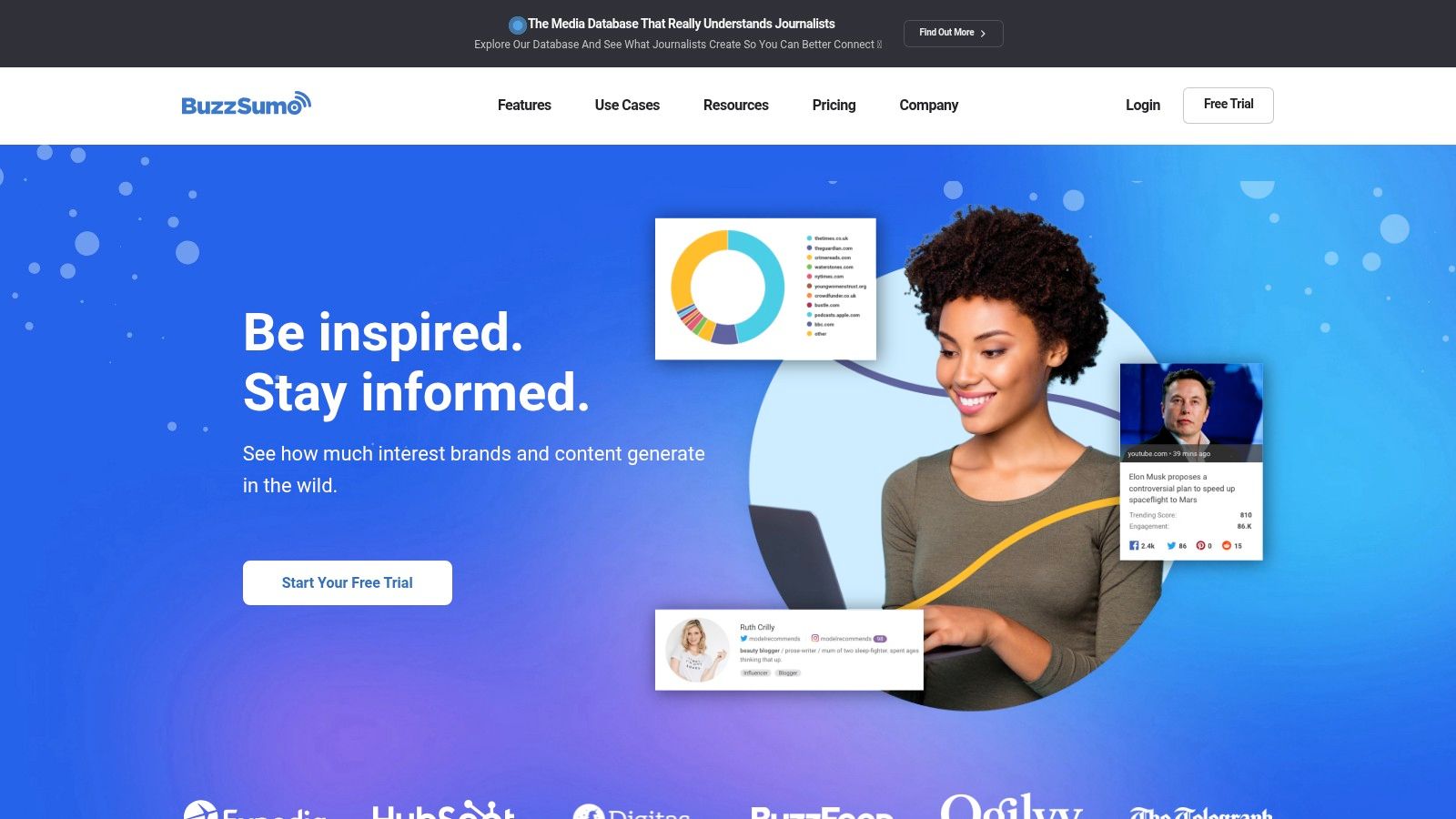
What makes BuzzSumo unique is its focus on engagement metrics (social shares, backlinks, evergreen score) as the primary indicator of success. Its powerful alerting system can notify you the moment a competitor publishes new content or when your brand is mentioned online, enabling rapid response and opportunity identification. This is invaluable for PR professionals looking to benchmark media coverage and for content marketers aiming to create data-driven editorial calendars that outperform the competition.
Core Features & Use Case
- Content Analyzer: Enter a competitor's domain or a topic to discover the most successful content based on social shares and backlinks.
- Media Database & Outreach: Find and vet relevant journalists and influencers who have covered your competitors or industry topics.
- Coverage Reports & Alerts: Track mentions of your competitors, your own brand, or keywords in real-time across millions of online sources.
- YouTube Analyzer: Analyze top-performing competitor videos to understand what formats, lengths, and topics drive engagement on the platform.
Pricing & Limitations
Pricing begins with the Content Creation plan at $199/month, which is higher than many basic SEO tools but offers generous search volumes. The full suite of PR and media outreach features is found in the PR & Comms plan at $299/month. While excellent for content and PR analysis, it lacks the broader technical SEO, PPC, and market-level traffic analytics found in all-in-one platforms. Its strength is its specialization, which may require you to pair it with another tool for a complete picture.
- Website: https://buzzsumo.com
8. Brandwatch
Brandwatch is an enterprise-grade consumer intelligence platform that excels at social listening and brand monitoring, making it one of the best competitor analysis tools for understanding public perception and share of voice. It moves beyond simple social media mentions to provide deep insights into consumer sentiment, trending topics, and key conversations surrounding your competitors. This allows marketing teams to analyze how rivals are perceived, identify their most impactful campaigns, and spot emerging market trends before they become mainstream.
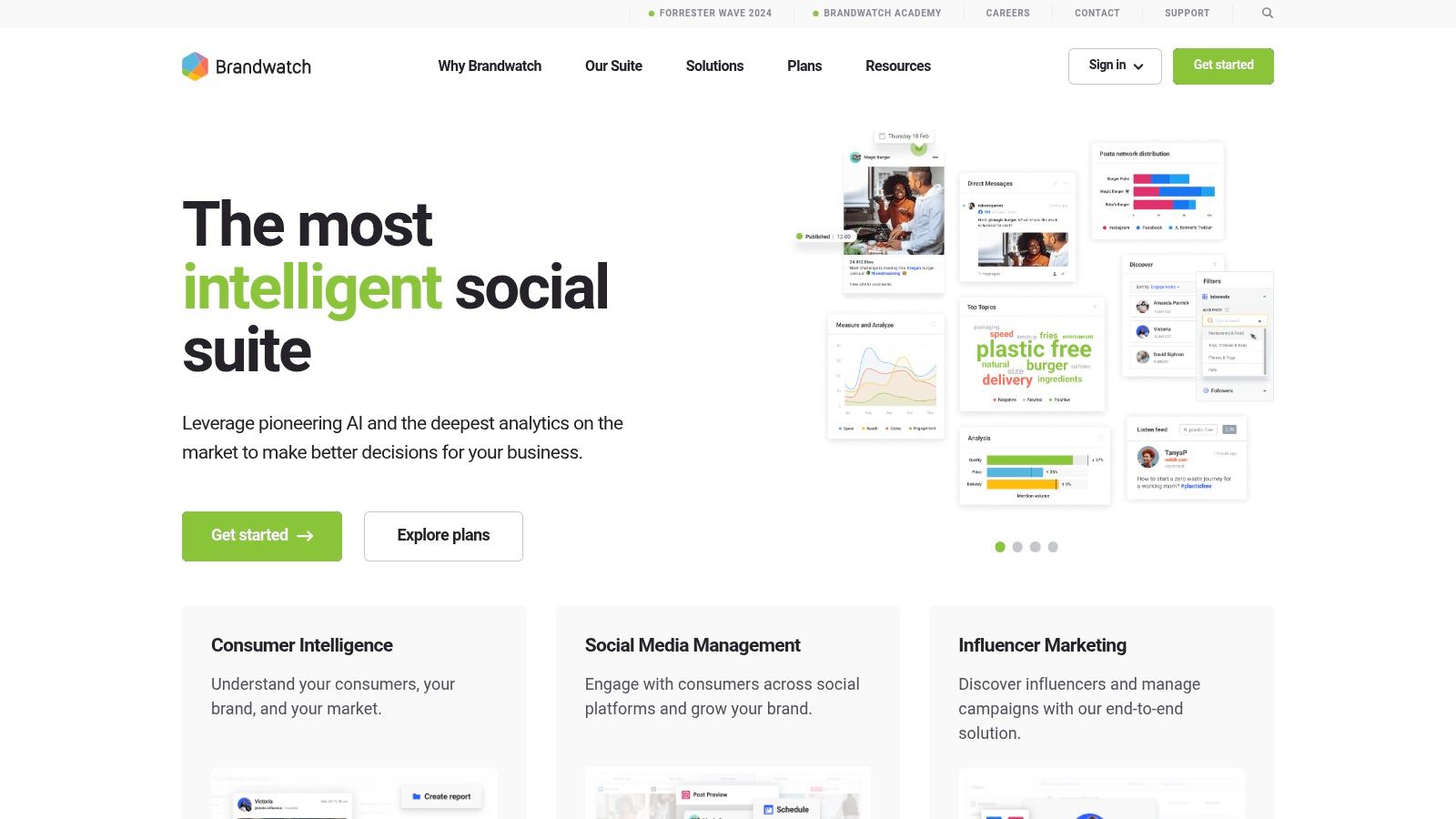
What truly distinguishes Brandwatch is its powerful AI, Iris™, which automatically surfaces insights and anomalies in your data, saving analysts significant time. For competitor analysis, this means you can instantly identify spikes in negative sentiment for a rival or uncover the key influencers driving their brand conversations. This level of automated intelligence allows you to react quickly to competitive shifts and inform your own strategy with real-time, qualitative data from across the web.
Core Features & Use Case
- Consumer Intelligence: Track brand health, share of voice, and audience sentiment for multiple competitors across social media, forums, blogs, and news sites.
- Influencer Marketing Suite: Identify and vet the creators and influencers your competitors are partnering with to understand their reach and engagement strategies.
- Flexible Dashboards & Alerts: Build custom reports comparing your brand against key rivals and set up real-time alerts for significant changes in their online presence.
Pricing & Limitations
Brandwatch does not publish its pricing publicly, as it is geared toward enterprise clients with custom needs, typically requiring significant budgets. Access to the platform is sales-led, meaning you must request a demo to get started. While its data coverage and analytical power are industry-leading, the high cost and complexity make it less suitable for small to mid-sized businesses looking for a straightforward, self-serve tool.
- Website: https://www.brandwatch.com
9. Crayon
Crayon is a dedicated competitive intelligence (CI) platform designed for organizations building a formal CI and sales enablement program. It moves beyond typical digital channel analysis by aggregating a competitor's complete digital footprint, from website and pricing changes to document updates and news mentions. This external data is then enriched with internal signals from your own GTM channels, like Slack and sales calls, to provide a holistic intelligence view. Its focus on automating the creation of CI deliverables makes it one of the best competitor analysis tools for teams that need to arm their revenue teams with timely, actionable insights.
What truly sets Crayon apart is its focus on the entire CI lifecycle, from capture to distribution. It uses AI to score the importance of competitor changes and detect anomalies, ensuring your team focuses on what matters most. The platform is engineered to translate raw data into battlecards, reports, and real-time alerts, which can be distributed directly to sales and marketing teams within the tools they already use. This closed-loop system ensures that intelligence doesn't just sit in a dashboard but actively drives strategic decisions and competitive wins.
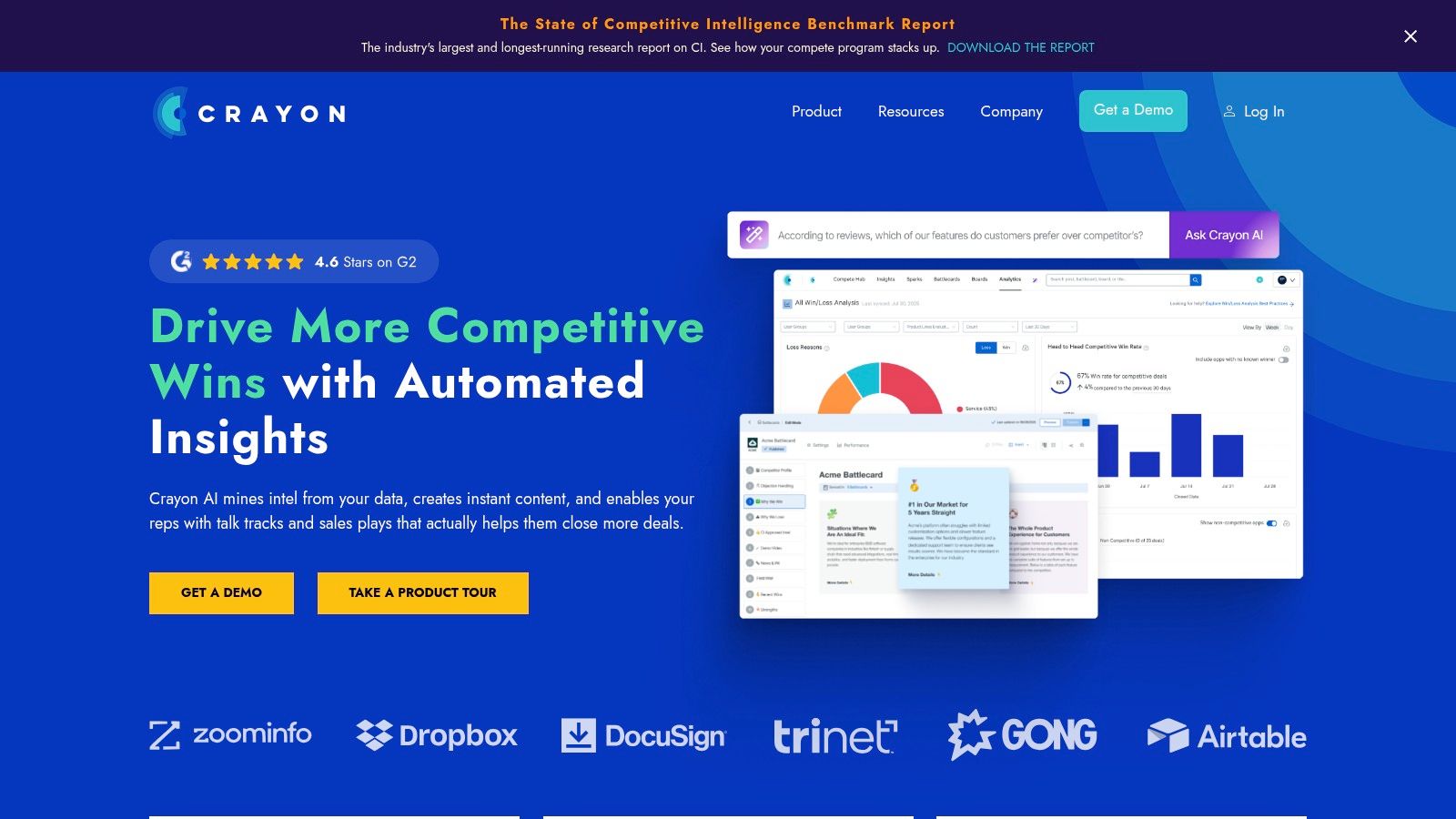
Core Features & Use Case
- Automated Change Tracking: Monitors over 100 data types across competitors' digital footprints, using AI to surface the most critical updates.
- Internal Signal Enrichment: Captures GTM insights from internal channels like Slack and CRM platforms to add context to external market data.
- Generative AI Insights: Utilizes AI to generate summaries, talking points, and battlecards, drastically reducing the manual effort required to create and distribute CI assets.
Pricing & Limitations
Crayon's pricing is quote-based and tailored to mid-market and enterprise organizations committed to building a robust CI function. The investment is significant, making it less suitable for small businesses or teams just starting with competitor research. Realizing the platform's full value requires strong cross-functional adoption, as its power lies in connecting market intelligence with internal revenue-generating activities and teams.
- Website: https://www.crayon.co
10. Klue
Klue is a competitive enablement platform designed to operationalize competitor intelligence directly into the workflows of revenue-generating teams. Unlike traditional analytics tools that focus on data collection, Klue excels at aggregating competitive signals, curating insights, and delivering them as actionable battlecards and enablement content. This makes it one of the best competitor analysis tools for organizations aiming to scale their CI programs and directly impact sales win rates and product strategy.
The platform's core strength lies in its ability to bridge the gap between intelligence gathering and practical application. By integrating with tools like Salesforce, Slack, and Highspot, Klue ensures that product marketers and CI managers can equip sales reps with the latest competitor information exactly when and where they need it. This focus on adoption and enablement is what sets it apart, turning static analysis into dynamic, revenue-driving action.
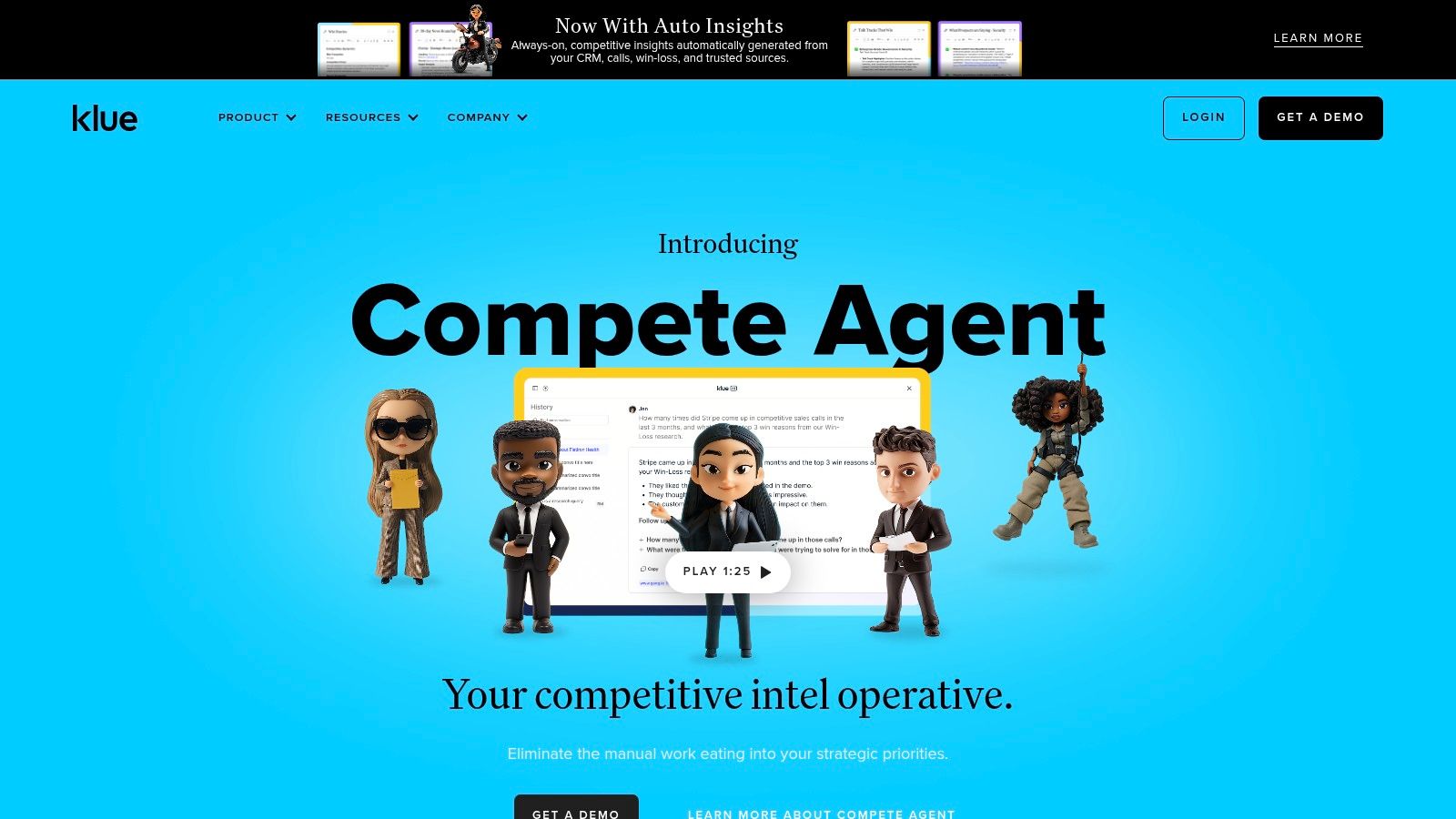
Core Features & Use Case
- Competitive Intel Aggregation: Automatically collects competitive signals from across the web, internal documents, and CRM data into a central repository.
- Battlecard & Content Creation: Provides structured templates and workflows for creating and updating dynamic sales battlecards, feature comparisons, and win-loss analyses.
- Sales Enablement Delivery: Integrates directly into CRMs and sales tools to deliver timely intel to reps during prospect calls and deal cycles.
Pricing & Limitations
Klue does not offer public pricing; access requires a custom quote following a sales-led demo. This enterprise-focused model means it is likely a significant investment compared to self-service analytics tools. The platform's effectiveness is also highly dependent on establishing strong cross-team processes for both intelligence contribution and content utilization. Without organizational buy-in from sales, product, and marketing, achieving a positive ROI can be challenging.
- Website: https://klue.com
11. Sensor Tower
Sensor Tower is a specialized mobile market intelligence platform designed for app and game publishers who need to dominate the app ecosystem. It moves beyond traditional web analytics to provide deep, actionable insights into the competitive landscape of the Apple App Store and Google Play. This platform is one of the best competitor analysis tools for teams focused on mobile growth, offering precise data on competitor downloads, revenue estimates, user engagement, and advertising strategies.
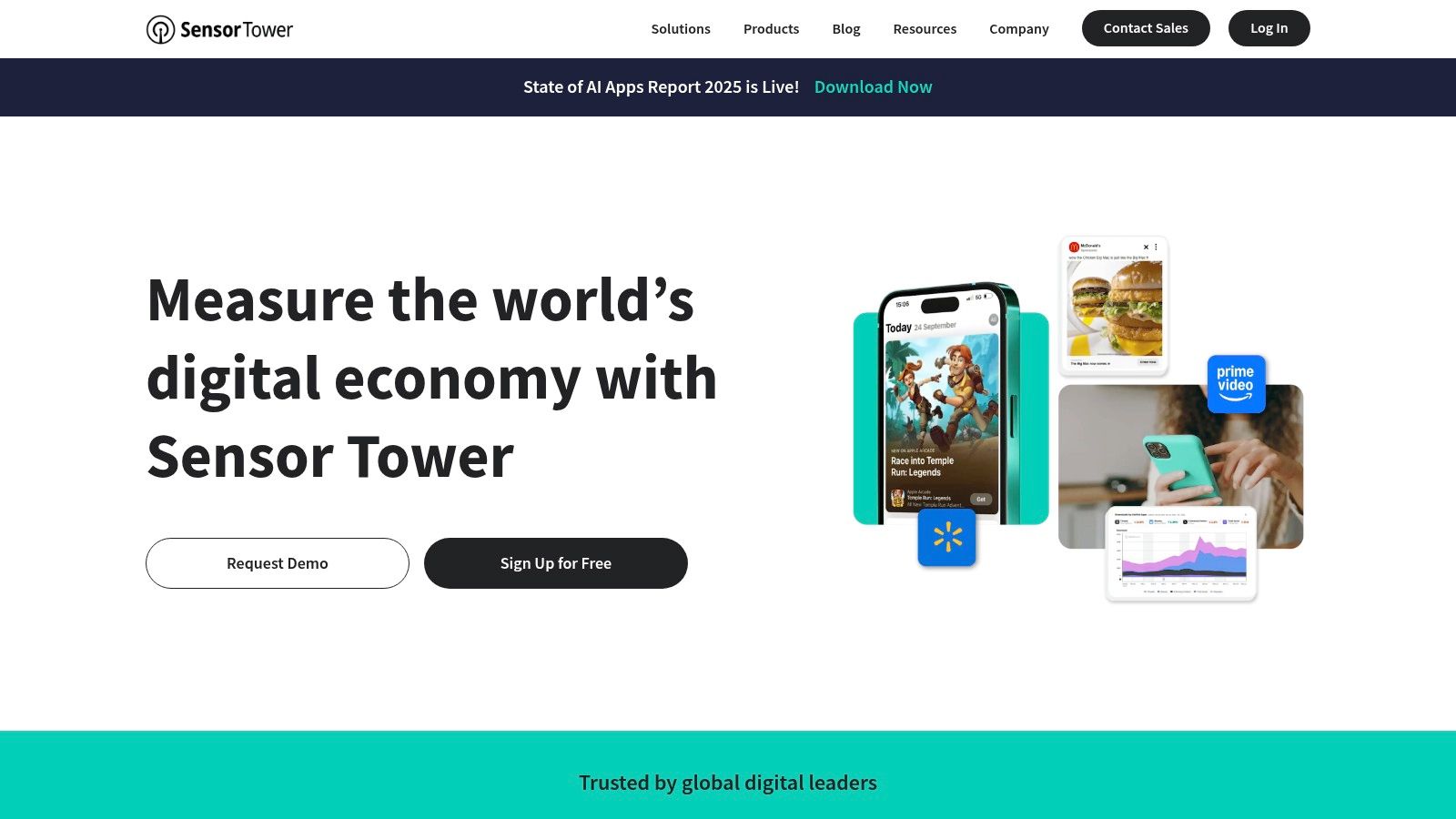
What makes Sensor Tower a market leader is its focus on granular app-centric data. You can benchmark performance across different countries, dissect top-performing ad creatives from rival apps, and monitor category trends to spot emerging opportunities. For a deeper dive into improving your app's visibility and conversion, explore this comprehensive App Store Optimization (ASO) guide to apply these competitive insights effectively. The platform's powerful segmentation allows you to analyze market share with precision, making it essential for strategic planning.
Core Features & Use Case
- App & Store Intelligence: Get accurate download and revenue estimates for any app, track keyword rankings, and analyze app update timelines.
- Ad Intelligence: Uncover competitors' mobile ad strategies by viewing their top ad creatives, networks, and share-of-voice across major platforms.
- Market Intelligence: Analyze macro trends at the category or market level, identify breakout apps, and leverage an API for enterprise data integration.
Pricing & Limitations
Pricing is not publicly available and is structured around enterprise-level annual contracts. Access to advanced modules like Ad Intelligence or the full historical dataset requires a custom quote and demo with their sales team. This high-touch, high-cost model makes it inaccessible for small developers or indie hackers, positioning it strictly as a tool for established publishers and marketing agencies with significant budgets.
- Website: https://sensortower.com
12. Wappalyzer
Wappalyzer takes a different approach to competitor analysis, focusing entirely on the technology stack that powers a website. Instead of dissecting keywords or backlinks, this tool uncovers the CMS, analytics tools, marketing automation platforms, and programming languages your competitors use. This makes it one of the best competitor analysis tools for tech-focused sales, partnership development, and market segmentation, allowing you to understand a rival's operational infrastructure.
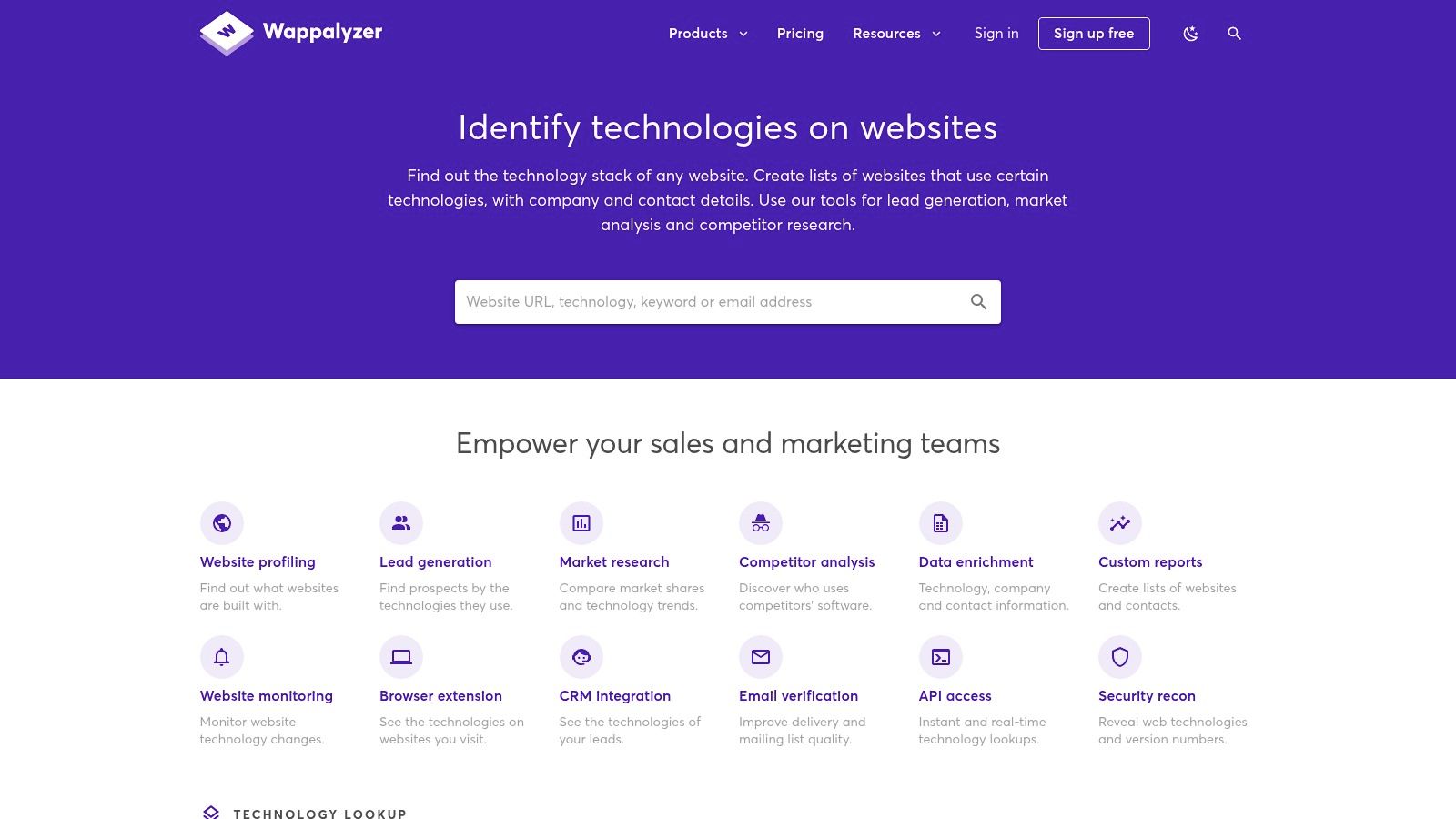
What makes Wappalyzer unique is its direct application for sales and marketing intelligence. You can build targeted lead lists based on specific technologies a company uses, for example, creating a list of all websites using HubSpot and Salesforce. This insight allows for highly personalized outreach and helps you identify which competitors have invested in specific software ecosystems, revealing potential strategic priorities or technical limitations.
Core Features & Use Case
- Technology Profiling: Instantly identify the full tech stack of any website using the browser extension or website lookup.
- Lead List Creation: Build and export targeted lists of companies based on the technologies they use, their location, and traffic levels.
- Website Alerts: Monitor competitors and receive notifications when they add or remove a specific technology from their website.
Pricing & Limitations
Wappalyzer offers a free plan with 50 monthly lookups. Paid plans start with the Starter plan at $49/month (billed annually) for 250 lookups and 250 list credits, scaling up to enterprise tiers. The platform's core limitation is its narrow focus; it provides no SEO, PPC, or traffic metric intelligence. Its value is almost exclusively in technical reconnaissance, making it a supplementary tool rather than a standalone competitor analysis platform.
- Website: https://www.wappalyzer.com
Top 12 Competitor Analysis Tools Comparison
| Product | Core features & USP ✨ | Quality ★ | Price & value 💰 | Best for 👥 |
|---|---|---|---|---|
| Pages.Report 🏆 | ✨ ~370–400 SaaS landing pages, Figma‑ready templates, optimized headlines, Webflow/Framer code, weekly audits | ★★★★☆ actionable | 💰 Free tier + promo lifetime ~$29; Pro includes audits | 👥 SaaS founders, PMs, growth marketers, designers |
| Semrush | ✨ All‑in‑one SEO/PPC, Market & Traffic Intelligence, Kompyte battlecards | ★★★★★ comprehensive | 💰 Tiered subscription; add‑ons and seats increase cost | 👥 SEO/marketing teams, agencies |
| Ahrefs | ✨ Best‑in‑class backlink index, Site/Keywords/Content Explorer, rank tracking | ★★★★★ backlink leader | 💰 Subscription tiers with crawl credits/limits | 👥 SEO/content teams, link builders |
| Similarweb | ✨ Market & traffic benchmarking, audience insights, historical data | ★★★★☆ enterprise‑grade | 💰 Enterprise pricing; deeper history at higher tiers | 👥 Market analysts, enterprise teams |
| SpyFu | ✨ PPC/organic keyword & ad history, domain vs. domain, lead exports | ★★★★ value‑focused | 💰 Affordable, transparent plans | 👥 SMBs, budget marketers |
| Adbeat | ✨ Display/native creative & placement discovery, publisher comparisons | ★★★★ ad intelligence | 💰 Higher tiers for full access; limited trials | 👥 Media buyers, creative teams |
| BuzzSumo | ✨ Content performance, backlinks, journalist/PR outreach, trending topics | ★★★★ content/PR focused | 💰 Mid–high entry price; PR features on higher tiers | 👥 Content marketers, PR teams |
| Brandwatch | ✨ Enterprise social listening, sentiment, influencer DB, AI analysis | ★★★★★ enterprise leader | 💰 Custom enterprise pricing (sales‑led) | 👥 Enterprise social & insights teams |
| Crayon | ✨ Website/change tracking, GTM signals, AI battlecard generation | ★★★★ CI automation | 💰 Quote‑based; aimed at orgs with CI programs | 👥 Competitive intelligence & enablement teams |
| Klue | ✨ Battlecards, enablement distribution into CRM/sales workflows | ★★★★ enablement‑focused | 💰 Sales‑led pricing; demo required | 👥 Revenue teams, sales enablement |
| Sensor Tower | ✨ App store downloads/revenue estimates, ad creatives, ASO insights | ★★★★ app market standard | 💰 Enterprise contracts; custom pricing | 👥 Mobile publishers, app marketers |
| Wappalyzer | ✨ Tech‑stack detection, bulk lookups, lead lists, browser extensions | ★★★★ practical | 💰 Free monthly lookups; paid bulk/API plans | 👥 Sales/tech researchers, marketers |
Choosing the Right Tool to Turn Insights into Action
Navigating the crowded market of competitor analysis tools can feel overwhelming, but the journey ends with a powerful realization: the goal is not to find a single, universally "best" tool, but to build a strategic toolkit that perfectly aligns with your business objectives. Throughout this guide, we've explored a diverse range of platforms, from comprehensive SEO giants to highly specialized intelligence solutions. Your task now is to translate this knowledge into a decisive, actionable choice that will empower your team.
The key is to move beyond feature lists and focus on outcomes. Are you a product manager trying to understand user acquisition funnels? Or a content marketer aiming to dominate search rankings? The right tool for one is not necessarily the right tool for the other.
Synthesizing Your Strategy: From Data to Decision
The most effective competitive intelligence programs don't rely on a single source of truth. Instead, they blend broad market awareness with deep, granular insights. An all-in-one suite like Semrush or Ahrefs provides the foundational layer, giving you a 360-degree view of your competitors' digital footprint, from SEO and PPC to content performance. These platforms are the bedrock of any serious digital marketing strategy.
However, true competitive advantage often lies in specialization. For instance, if your primary growth channel is paid advertising, a dedicated tool like SpyFu or Adbeat will deliver a level of detail on ad copy, spend, and creative that generalist tools cannot match. Similarly, if your success hinges on content marketing and PR, BuzzSumo is indispensable for identifying viral topics and influential voices in your niche.
Aligning Your Toolkit with Your Team's Needs
Choosing the best competitor analysis tools also involves considering who will use them and how. Your selection process should be guided by specific team goals and workflows.
-
For Marketing & SEO Teams: The core need is often keyword gap analysis, backlink monitoring, and traffic estimation. Here, the choice between Ahrefs, Semrush, and Similarweb comes down to UI preference, data accuracy in your specific industry, and budget.
-
For Product & Design Teams: Understanding a competitor's technology stack and user experience is paramount. Wappalyzer offers a quick, efficient way to see what's under the hood, while a tool like Pages.Report provides deep, actionable insights into landing page design patterns, copy, and conversion funnels. This helps teams build better products, not just better marketing campaigns.
-
For Sales & Competitive Enablement Teams: The goal is to operationalize intelligence for the front lines. Platforms like Klue and Crayon are purpose-built for this, turning market shifts and competitor updates into battlecards and timely alerts that help sales reps win more deals.
Implementation: The Final, Critical Step
Once you've made your selection, successful implementation is crucial. Don't just subscribe to a tool; integrate it into your team's regular cadence. Schedule weekly reviews of competitor keyword movements, set up automated alerts for new ad campaigns, and create a shared dashboard for key metrics. The real value of these platforms is unlocked when they become a consistent, proactive part of your strategic planning, not just a reactive tool for occasional check-ins.
Ultimately, competitive analysis is not about imitation; it's about inspiration and innovation. By selecting the right tools, you empower your team to stop looking over their shoulders and start confidently charting their own course forward. Use the insights you gather not just to react to the market, but to proactively shape it, creating a durable advantage that leaves your competition scrambling to catch up.
Ready to move from high-level traffic data to the specific design and copy strategies that drive conversions? Pages.Report is the specialist tool designed for SaaS teams who want to deconstruct competitor landing pages to build better ones. Get an unfair advantage by analyzing the proven patterns, value propositions, and social proof your rivals use to win customers by visiting Pages.Report today.
